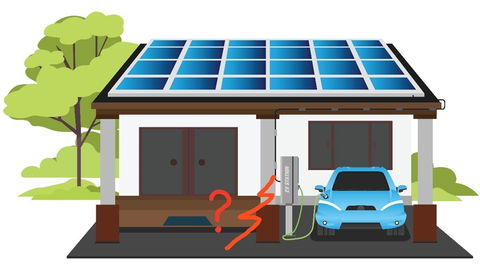This article covers key points relating to RCD selection, detailed in Section 10; IET Code of Practice for EV Charging Equipment Installations.

722 Amendment 2 – Design Rules
The IET Code of Practice (CoP) for EV Charging Equipment Installations 4 th Edition gives detailed design requirements, based on BS 7671 e.g. for a basic domestic charging instal supplied directly from the mains, the RCD selection for Mode 3 charging is straight forward; see 722.531.3.101 Amd 2. If the charge point contains 6 mA smooth DC detection, a single 30 mA Type A RCD can be mounted in the charge point or upstream based on the installation design requirements - see CoP clause 5.6.2.
Installation designs containing a Vehicle-to-Grid (V2G) or V2H (Home) features are more complex. The cable connecting the V2G charging equipment to the main distribution board, running in EV charging mode or storage mode may require two RCDs -why? In charging mode the 30 mA RCD mounted in the V2G charging equipment may trip with a fault located upstream, but obviously it does not disconnect the supply to the fault. If the design rules require RCD protection for the supply cable, an additional RCD mustbe installed at the origin of cable supplying the EV charger - reference CoP EV Charging Installations section 10 Fig 9.8 page 86.
Figure 1 IET CoP EVCI section 10 Fig 9.8 page 86.
V2G Inverters and Types of RCD
The CoP for Electrical Energy Storage systems Table 9.4 page 98: Specifies selection requirements for Types of RCD used in circuits containing Bi-directional inverters. This is applicable to Fig 1 V2G charge controllers.
Consider the guidance given in the associated IET CoPs for safe installation designs, before deciding on the final design of the installation. Check the V2G equipment manufacturer’s installation specification for any specific RCD requirements related to their product. When mounting RCDs in series; note the flow of residual currents through the RCDs and location of the RCDs with respect each other and any selectivity requirements. For example smooth DC fault currents, associated with two EV chargers containing 6 mA DC detection would preclude the use of Type A or F upstream due to the summation of DC fault currents i.e. in this case 12 mA. See 722.531.3.101 Amd 2 Note 1 referring to Regulation 531.3.3 – Selecting the appropriate Type of RCD see Note 1, 2 & 3.
State of the Art
With modern technologies the “State of the Art” is an important concept to consider in relation to COPs and the year of publication. BS 7671 Amd. 2 Regulation 531.3.3 layouts the basic characteristics, and requirements for RCD Types. Markets drive Standardization and new product developments. For example there is nothing to stop a manufacturer developing Type B with a lower smooth DC detection threshold, to limit smooth DC to 6 mA, enabling their use downstream of Type A in single load applications on one feeder. It is just down to cost and sufficient demand to warrant the design and manufacturing outlay for an application specific device.
Conclusion
The revised Code of Practice for EV Charging Equipment Installations 4 th Edition and BS7671 Amendment 2 detail basic requirements for safe design. The IET Code of Practice for Electrical Energy Storage Systems is relevant to complex installations containing battery back-up systems incorporating EV charging as well. Check the V2G equipment manufacturer’s specification for specific RCD requirements and any additional equipment requirements to meet BS7671. With existing RCD protection on the main incoming supply, consider the design carefully e.g. RCD Type, Sensitivity and Selectivity if relevant. Equipment that fails to at least meet the existing regulations, will not provide the expected level of protection and service appropriate to modern installations. For further information on RCDs please refer to the Doepke Web Site Product selection and Download pages.
Chaz Andrews – Technical Manager, Doepke UK Ltd
